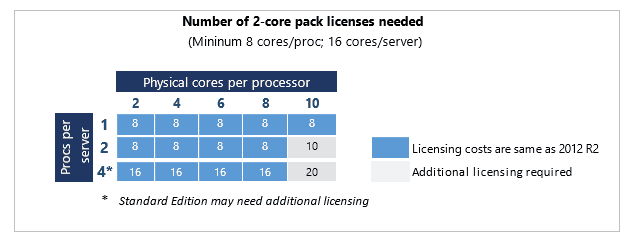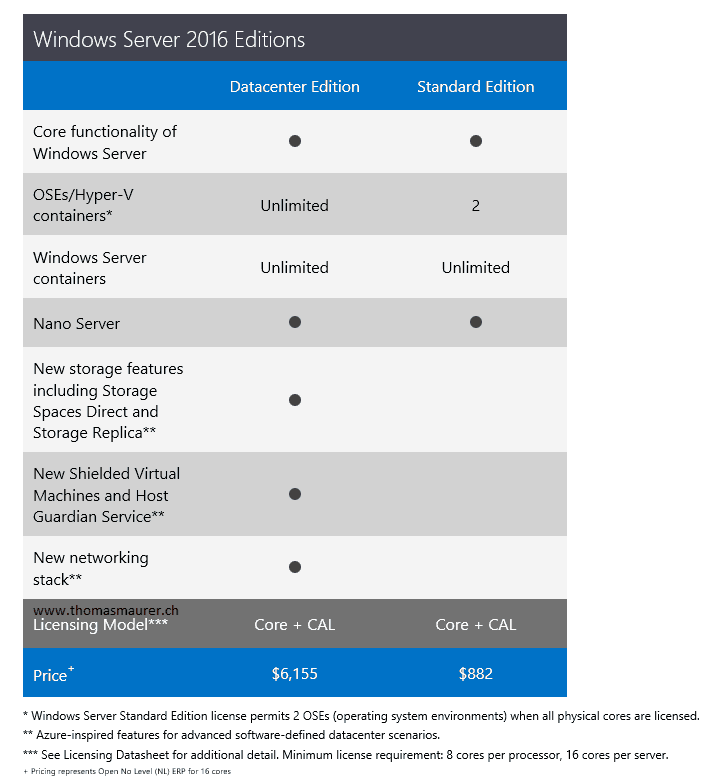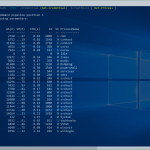Last night Microsoft released more information about Windows Server 2016. We already got some interesting technical feature information such as Hyper-V, Containers, Nano Server and much more. This is the first time Microsoft is talking about Windows Server 2016 licensing.
Let’s start first with a disclaimer here: All information on the blog are coming from the Microsoft papers released in December 2015. The information maybe change in the future or are not correct written on my blog. This blog post just wants to give you a little consolidated overview about the licensing changes. If you want to make sure you will be licensed correctly, connect with Microsoft and/or Microsoft Partner.
Microsoft still will have two version of Windows Server 2016 with Datacenter and Standard edition, as they had in Windows Server 2012 and Windows Server 2012 R2. There are two big changes in licensing of Windows Server 2016. For Windows Server 2016 Microsoft is changing from a per-processor licensing to per-core licensing for Windows Server 2016 Standard and Datacenter Editions. And the second big change is that there is no feature parity between Standard Edition and Datacenter Edition. In Windows Server 2012 R2 you basically had the same features in both editions and the only difference were Virtual Machine use rights. (Except for one feature called Automatic Virtual Machine Activation.) There is also some interesting scenarios for hybrid cloud deployments using the Azure hybrid use benefit.
I picked some of the interesting parts out of the Microsoft released papers:
Windows Server 2016 Editions:
- Datacenter Edition for highly virtualized private and hybrid cloud environments.
- Standard Edition for non-virtualized or lightly virtualized environments.
- Information about other editions of Windows Server 2016 and Windows Storage Server 2016 will be provided in Q1 2016

What does the change to a Cores + CAL based licensing model bring:
To license a physical server, all physical cores must be licensed in the server. A minimum of 8 core licenses is required for each physical processor in the server and a minimum of 16 cores is required to be licensed for servers with one processor.
- The price of 16-core licenses of Windows Server 2016 Datacenter and Standard Edition will be same price as the 2 proc license of the corresponding editions of the Windows Server 2012 R2 version.
- Standard Edition provides rights for up to 2 OSEs or Hyper-V containers when all physical cores in the server are licensed. Multiple licenses can be assigned to the same cores for additional OSEs or Hyper-V containers.
- Each user and/or device accessing a licensed Windows Server Standard or Datacenter edition requires a Windows Server CAL. Each Window Server CAL allows access to multiple licenses Windows Servers.
- A Windows Server CAL gives a user or device the right to access any edition of Windows Server of the same or earlier version.
- Some additional or advanced functionality such as Remote Desktop Services or Active Directory Rights Management Services will continue to require the purchase of an additive CAL.
How to license the physical cores for Windows Server 2016 Standard and Datacenter Editions
- License all the physical cores in the server
- Minimum of 8 core licenses required for each proc
- Minimum of 16 core licenses required for each server
- Core licenses will be sold in packs of two.
- 8 two-core packs will be the minimum required to license each physical server.
- The two-core pack for each edition is 1/8th the price of a two proc license for corresponding 2012 R2 editions.
FAQ:
Some information form the Microsoft FAQ;
- How do I license Nano Server?
Nano Server is a deployment option within Windows Server 2016. It is included as part of the licensing of the edition from which it is deployed. There is no unique or separate licensing for Nano Server. - Where is the information about other editions of Windows Server, Windows Storage Server, Azure Stack and other products coming next year?
More information is coming in Q1CY16 about Azure Stack, Windows Server Essentials and the rest of the Windows Server editions and other related products. - Are CALs still required for Windows Server 2016?
Windows Server Standard and Datacenter editions will continue to require Windows Server CALs for every user or device accessing a server.. Some additional or advanced functionality will continue to require the purchase of an additive CAL. These are CALs that you need in addition to the Windows Server CAL to access functionality, such as Remote Desktop Services or Active Directory Rights Management Services. - What are the changes for Hyper-V?
Standard Editions still allows you to use two virtual OSEs and Datacenter allows you to use unlimited virtual OSEs, but they are now not licensed on processor or servers, they are now licensed based on cores. - What about Hyper-V Containers and Windows Containers?
Hyper-V Containers are licensed the same as Hyper-V Virtual Machines. No information about Windows Containers right now. - How should I think about hyper-threading in the core based licensing?
Windows Server and System Center 2016 are licensed by physical cores, not virtual cores. Therefore, customers only need to inventory and license the physical cores on their processors. - If processors (and therefore cores) are disabled from Windows use, do I still need to license the cores?
If the processor is disabled for use by Windows, the cores on that processor do not need to be licensed. For example, if 2 processors in a 4 processor server (with 8 cores per processor) were disabled and not available for Windows Server use, only 16 cores would need to be licensed. However, disabling hyper threading or disabling cores for specific programs does not relieve the need for a Windows Server license on the physical cores. - I read that Windows Server 2016 will support nested virtualization-a VM running inside a VM. How do you license that scenario?
Windows Server 2016 Datacenter licensing allows for unlimited virtualization and so would easily cover this scenario. Windows Server 2016 Standard Edition licensing is for low to no virtualization scenarios and supports up to two virtual machines. A virtual machine running inside a virtual machine counts as two virtual machines from licensing perspective.
You can get more information about the next version of Windows Server on the Windows Server 2016 website. And the following resources:
- Download the Windows Server 2016 Datacenter and Standard Edition licensing datasheet
- Download the Windows Server 2016 and System Center 2016 licensing FAQ
Tags: Azure, Containers, Hyper-V, Licensing, Microsoft, Nano Server, Virtualization, Windows Server, Windows Server 2016, Windows Server Licensing Last modified: July 7, 2019














Thank you for posting this, you made my research easier.
Hello please do you sale Windows Server 2016 Remote Desktop Services
So if you have a quad core servers, you still have to buy 16 cores…
What is the purpose of having per core licensing if Microsoft then restricts them to 16 per server minimum or in packs of 2?
Everyone saying this will not affect smaller companies is wrong. While Microsoft didn’t increase the price, they increased the requirements, so you have to license 16 cores, even if you have want to use 4 or 6 or 8. This affects virtualization in a hefty way. And what is the point of disabling cores on Windows or your VM’s if you still have to license the whole physical servers. And lets not forget CAL’s which are extra again.
This seems like a way to punish both small deployments and big deployments. The middle ones are going to get the same pricing as long as they don’t scale down or up. Which is awkward in a world where companies want exactly that. This is extremely anti-cloud and anti-virtualization if you are not running DC and using Hyper-V.
For bigger environments, licensing the DC edition on each core, will be horrible expensive. So the choice will be, buy less powerful servers to pay less for licensing or a bigger server to run more VM’s. The result for the Windows ecosystem will be horrible. Smaller, and older servers with less processors will be left for Windows deployments and the powerful ones will be assigned to run Linux VM’s.
Result? Windows Server is slow and sucks in performance for end users.
If you have 2 8 cores cpus or less, you will pay exactly the same licensing as today with Windows Server 2012 R2.
Their chart is misleading on the first row. They show a 1 processor machine with 2, 4, or 8 cores as being the same price as 2012R2. That is simply untrue. Why on earth would you buy 2 processor licenses for a 1 processor machine? The price is DOUBLE for all machines with only one CPU. If you have 2 CPU’s not exceeding 8 cores, then it’s the same cost.
They should have made it a minimum of 8 cores per machine and 8 cores per processor. We are a small shop and will not be upgrading for at least 4 years, as we recently purchased a really nice single processor 8 core system to run almost our entire shop. Why would we want to double our payment? And buy new CAL’s to boot?
Plus Windows 10 Anniversary Edition is still really buggy. I love MS but I think we’ll wait a few years before touching this one.
The chart is correct.
You always did buy a 2 proc license (also with 2012 and 2012 R2) you couldn’t buy a single core license. There was no one proc license!
Hi Thomas – question I am a SMB running ESXi Vsphere 6
– I have 3 hosts and collected licenses during the upgrades – I need to buy Licenses for 16 windows 2012 vm servers but now only Windows 2016 exist – what do I need to buy ? How do I even know what to buy? In the past you could buy 9 x 2012 R2 license which covers 2 OSE – just wondering what to do
hi thomas,
how about this configuration
i have 2 proc, 4 core per each processor, but i want to install 4 vm in ws std edition.
how much l need?
regards
You will need to license 2x8core for 2 vms, for 4 vms you need to do this twice. To definitely make sure please contact your account manager or LAR :)
What happens when the host server/cluster is Data centre 2012 (without SA) and you want to start using 2016 for new VMs?
I presume you just buy 2016 standard for those VMs? Can you mix both versions in one 2012 host/cluster?
Microsoft is now in the cloud business and it’s Windows Server 2016 pricing is proof of that. This is the beginning of a slow death to the traditional datacenter. Cloud computing is the future, and it will be expensive!
Thank you for the valuable information – do you have any intel about the future of CALs? I just had a discussion with my boss about buying 2016 User CALs with or without SA; if MS follows the Win10 model we will never have anything but Windows Server 2016 again, just different build numbers – thus rendering the need for user CAL upgrades in the future obsolete?? Is MS really going to be that benign?
we have a Netgear NAS that I am not so happy with the performance.
We have 15 PC’s which we all save and access files via the NAS Server.
I would like to have a simple file server ( where we only see files and folders if we click onto the Windows File Server).
Do I need multiple licensing if the Windows File Server is installed on 1 machine but its Hard Drive is accessed by 15 PC’s ?
There would be no Client Server on each PC. For each PC has its own Stand-Alone Windows 10 home edition
It’s complicated, your table doesn’t offer solution for high cores per socket (e.g. 20C or 22C) – so: what’s the price for dual socket server, each cpu has 20C/40T or 22C/44T ?
You can just think of extending the table with more grey boxes (think as it as additional licenses)